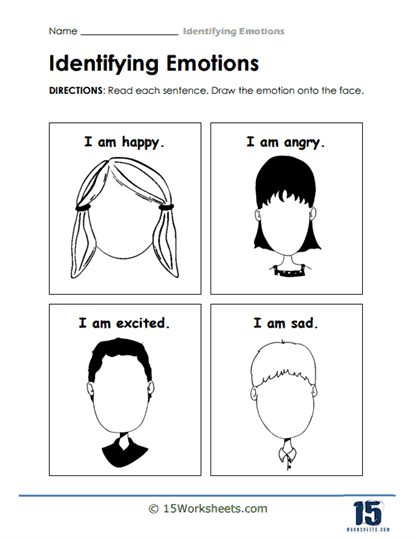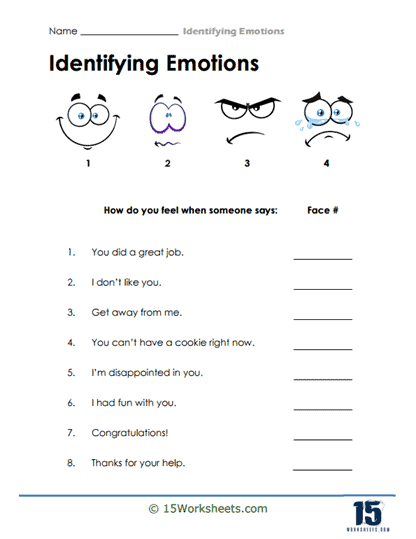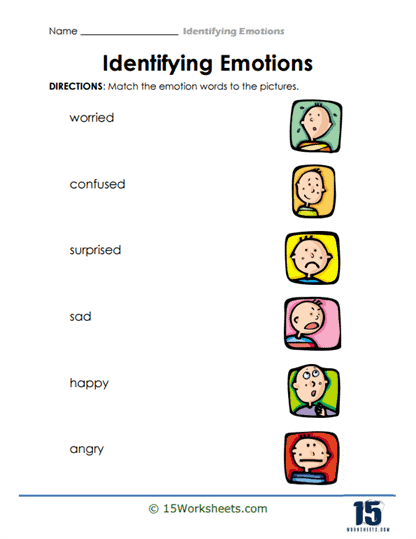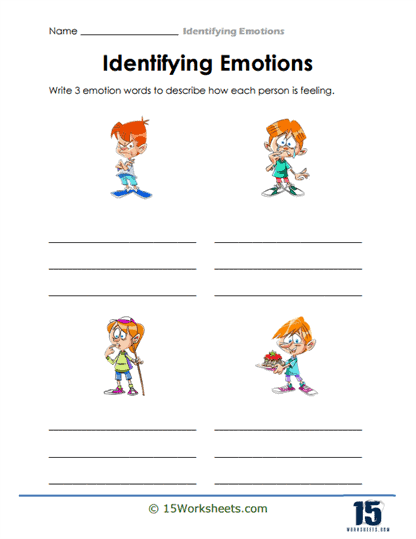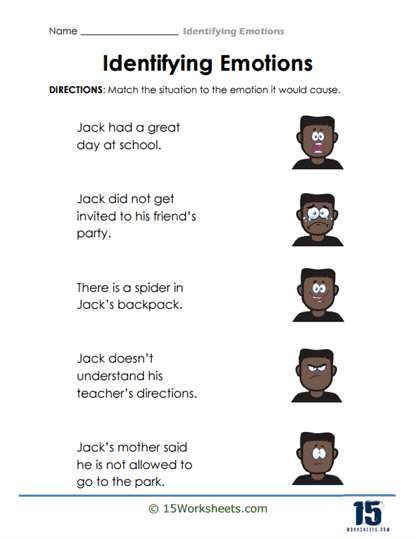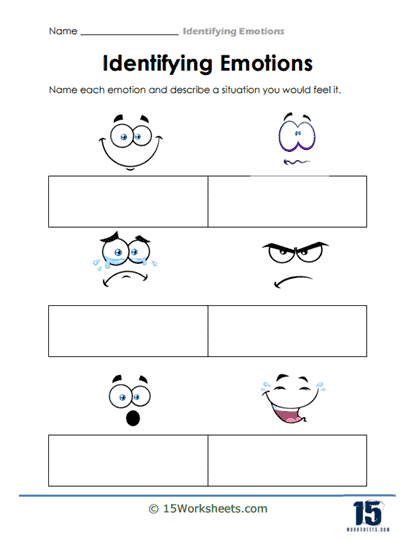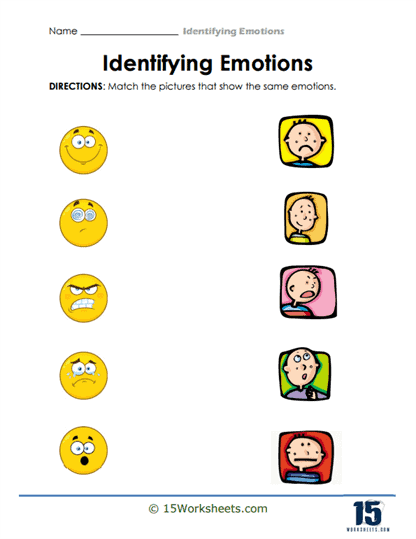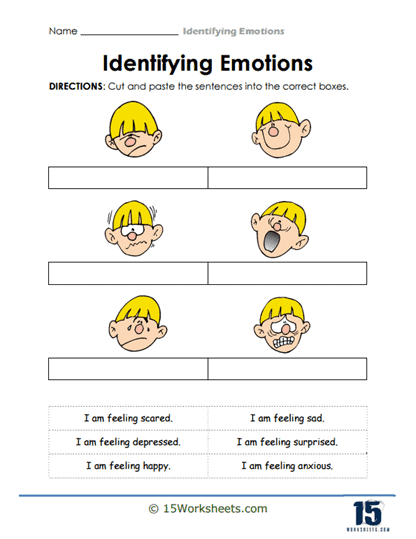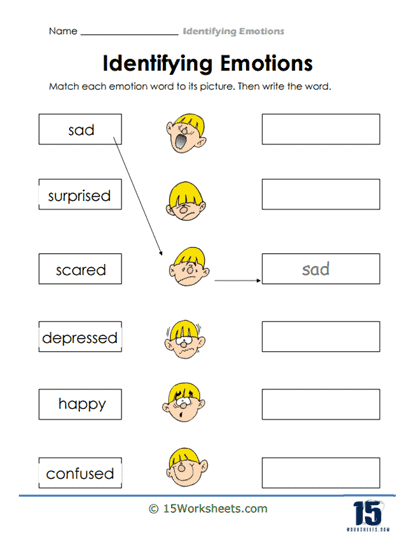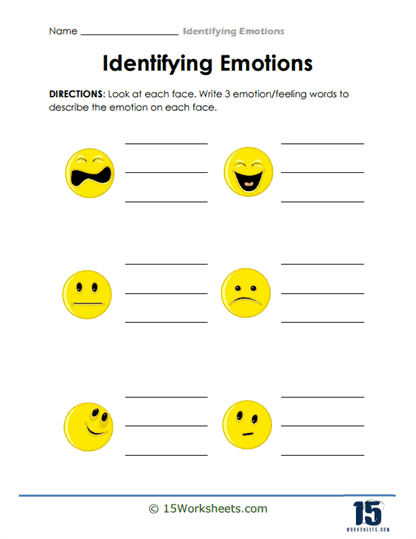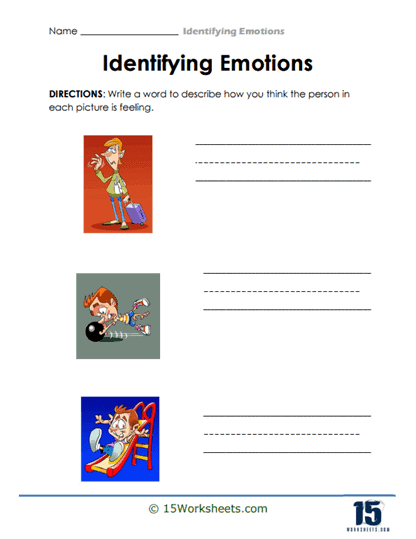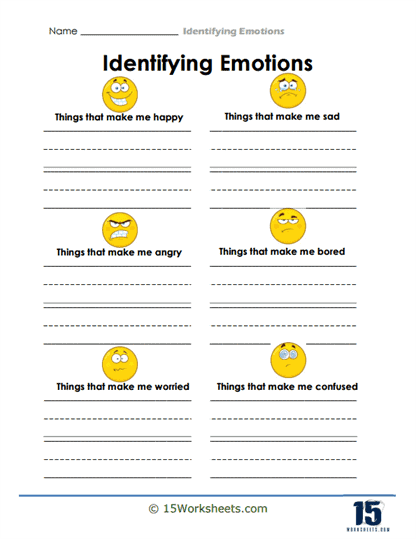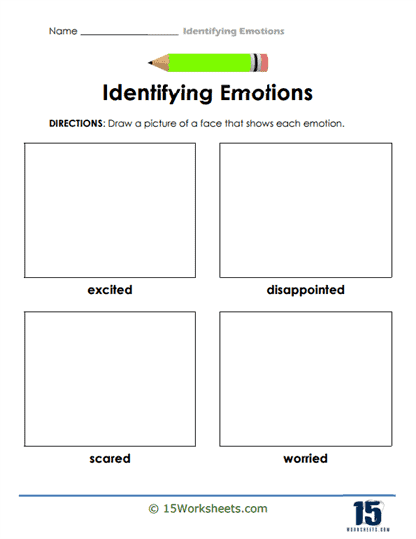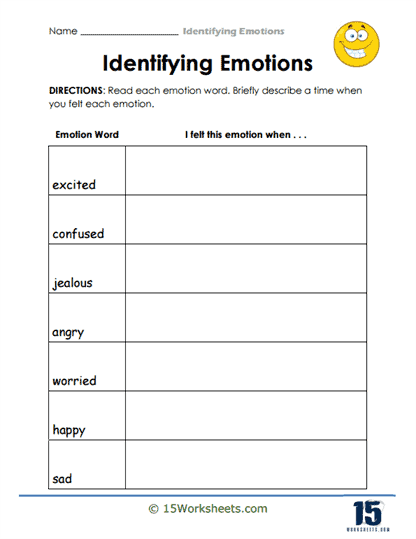Identifying Emotions Worksheets
About These 15 Worksheets
Understanding and managing emotions is a fundamental skill for students as they navigate their academic and personal lives. The Identifying Emotions Worksheets collection is an engaging and practical resource designed to help students develop emotional awareness and literacy. Through various activities, students learn to recognize, label, and understand different emotions, enabling them to articulate their feelings more effectively. This collection is ideal for teachers and homeschoolers looking to incorporate social-emotional learning into their curriculum, offering a range of exercises that are both educational and enjoyable.
One of the key activities in this collection is the “Cut and Paste” worksheet, where students match facial expressions to the correct emotions, such as happy, scared, surprised, or angry. This hands-on activity helps younger students make connections between visual cues and emotional states, fostering a foundational understanding of emotional recognition. Similarly, the “Draw the Emotion” worksheet asks students to illustrate facial expressions based on written descriptions, further reinforcing their ability to identify and express emotions visually.
Another engaging worksheet is the “Match the Emotion” activity, where students match emotion words like worried, confused, and happy with corresponding facial images. This exercise enhances vocabulary and comprehension skills, enabling students to expand their emotional vocabulary and improve their ability to communicate their feelings. The “Situational Emotions” worksheet goes a step further by presenting scenarios that students must pair with the appropriate emotional response. This helps students understand the context behind emotions, teaching them to anticipate and empathize with others’ feelings in various situations.
The collection also includes more reflective activities, such as the “Describe the Emotion” worksheet, where students write down words to describe how different characters might be feeling in specific situations. This type of exercise encourages deeper thinking about emotions, allowing students to explore the nuances of how and why people feel the way they do. By engaging in these exercises, students learn to differentiate between similar emotions and understand the complex nature of human feelings.
In addition to these specific worksheets, this collection could include activities such as “Emotion Journals,” where students record their daily emotions and reflect on what caused them, and “Emotion Charades,” a group activity where students act out different emotions for their peers to guess. These types of activities encourage students to express emotions in various forms, from writing to physical movement, reinforcing their emotional understanding in diverse ways.
These worksheets are available in PDF format, making them easily accessible for printing and use in both classroom and home settings. These resources are not only beneficial for students but also serve as valuable tools for educators and parents who wish to foster emotional intelligence in children. By incorporating these worksheets into daily learning routines, students can develop stronger emotional awareness, better communication skills, and a greater capacity for empathy, all of which are essential for their overall well-being and success.
This series offers a variety of activities that cater to different learning styles, ensuring that students can engage with the material in meaningful ways. Whether used in the classroom or at home, these worksheets are an effective tool for helping students understand, express, and manage their emotions, laying the foundation for healthy emotional development.
Identifying Emotional States
Identifying a person’s emotional state involves observing a combination of visual and audio cues that reflect their internal feelings. Visual cues are often the most immediate indicators of emotion, as they can be seen in facial expressions, body language, and other non-verbal gestures. For example, a person’s facial expressions can convey a wide range of emotions-such as a smile indicating happiness, furrowed brows signaling anger or concentration, and tears suggesting sadness or overwhelm. Eyes, in particular, can be very telling; they may appear wide and alert when someone is surprised or excited, or they may narrow when a person is feeling skeptical or suspicious.
In addition to facial expressions, body language plays a crucial role in conveying emotions. A person who is feeling confident might stand tall with an open posture, while someone who is anxious or uncomfortable might hunch their shoulders or cross their arms. Hand movements, too, can offer insights-tapping fingers might indicate impatience, while clenched fists could suggest anger or frustration. The way a person positions themselves relative to others can also be revealing; for instance, leaning in during a conversation might signal interest or enthusiasm, whereas leaning away could indicate discomfort or disinterest.
Beyond visual cues, audio cues such as tone of voice, speech patterns, and volume are equally important in identifying a person’s emotional state. The tone of voice can greatly affect the way a message is perceived, with a warm, upbeat tone generally indicating happiness or excitement, and a flat or monotone voice possibly suggesting boredom or sadness. Changes in pitch and volume also provide clues-someone speaking loudly and with a high pitch might be excited or agitated, while a soft, low-pitched voice could indicate shyness, fear, or sadness. The speed of speech is another indicator; rapid speech may reflect nervousness or excitement, while slow speech might suggest fatigue or calmness.
In conversations, the content of what is being said can also reveal a person’s emotional state. If someone is repeating certain phrases or words, it might indicate obsession or anxiety. Hesitation or frequent pauses in speech could suggest that the person is uncertain or uncomfortable with what they are discussing. Conversely, a person who speaks fluently and with ease might feel confident or relaxed.
Observing the combination of both visual and audio cues provides a more accurate understanding of a person’s emotions. For instance, if a person is smiling (a visual cue) but has a trembling voice (an audio cue), it might indicate that they are nervous or hiding their true feelings. Similarly, crossed arms paired with a firm, loud voice might suggest defensiveness or anger. It’s important to consider the context in which these cues are displayed, as certain emotions can manifest differently depending on the situation and the individual’s personality.
Understanding these cues not only helps in identifying how someone else is feeling but also enhances interpersonal communication. Being aware of others’ emotional states allows for more empathetic interactions, as one can adjust their behavior and responses accordingly. This skill is especially valuable in settings like classrooms, workplaces, or social gatherings, where effective communication and understanding are key to maintaining positive relationships.


